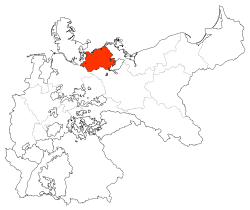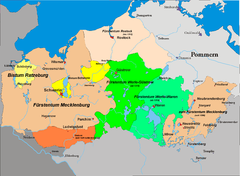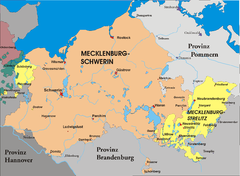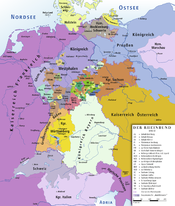- Mecklenburg-Schwerin
-
(Grand) Duchy of Mecklenburg-Schwerin
(Groß-)Herzogtum Mecklenburg-SchwerinState of the Holy Roman Empire (until 1806) ← 
1352–1918  →
→

Flag Coat of arms Mecklenburg-Schwerin within the German Empire Capital Schwerin Government Monarchy History - Mecklenburg
raised to duchy1348 - Separation of
Mecklenburg-Stargard1352 - Joined
Lower Saxon Circle1500 - First partition of
Mecklenburg-Güstrow1520 - Second partition of
Mecklenburg-Güstrow1621 - Partition of
Mecklenburg-Strelitz1701 - Disestablished 1918 Mecklenburg-Schwerin was a duchy (after 1815: grand duchy) in northern Germany created in 1348, when Albert II of Mecklenburg and his younger brother John were raised to Dukes of Mecklenburg by King Charles IV. Ruled by the successors of the Nikloting House of Mecklenburg, Mecklenburg-Schwerin remained a relatively poor state of the Holy Roman Empire along the Baltic littoral between Holstein and Pomerania.
Contents
History
The dynasty's progenitor, Niklot (1090-1160) was a chief of the Slavic Obotrite tribe federation, who fought against the advancing Saxons and was finally defeated in 1160 by Henry the Lion in the course of the Wendish Crusade. Niklot's son Pribislav submitted himself to Henry and in 1167 came into his paternal inheritance as the first Prince of Mecklenburg.
 Alternative full coat of arms.
Alternative full coat of arms.
After several divisions among Pribislav's descendants, Henry II of Mecklenburg (1266-1329) until 1312 acquired the lordships of Stargard and Rostock and bequested the reunified Mecklenburg lands - except the County of Schwerin and Werle - to his sons Albert II and John. After they both had received the ducal title, the former lordship of Stargard was recreated as the Duchy of Mecklenburg-Stargard for John in 1352. Albert II retained the larger western part of Mecklenburg and after he had acquired the former County of Schwerin in 1358, he made Schwerin his residence.
In 1363, Albert's son Duke Albert III campaigned in Sweden, where he was crowned king one year later. In 1436, the last Lord of Werle, William, died without a male heir. Because William's son-in-law, Ulric II of Mecklenburg-Stargard, had no issue, his line became extinct upon Ulric's death in 1471. All possessions fell back to Duke Henry IV of Mecklenburg-Schwerin, who was then the sole ruler over all of Mecklenburg.
In 1520 Henry's grandsons Henry V and Albert VII again divided the duchy, creating the subdivision of Mecklenburg-Güstrow, which Duke Adolf Frederick I of Mecklenburg-Schwerin inherited in 1610. In a second partition of 1621 he granted Güstrow to his brother John Albert II. Both were deposed in 1628 by Albrecht von Wallenstein as they had supported Christian IV of Denmark in the Thirty Years' War, nevertheless the Swedish Empire enforced their restoration three years later. When John Albert's II son, Duke Gustav Adolph of Mecklenburg-Güstrow died without male heirs in 1695, Mecklenburg was reunited once more under Duke Frederick William of Mecklenburg-Schwerin.
Frederick William however was challenged by his uncle Adolf Frederick II, the youngest son of Adolf Frederick I of Mecklenburg-Schwerin, who also claimed Güstrow, leading to a fierce succession dispute. In 1701 the parties, pushed by the Imperial states of the Lower Saxon Circle, settled their quarrels: The Duchy of Mecklenburg-Strelitz, roughly a recreation of the medieval Stargard lordship, was split off and given to Adolf Frederick II. The continued conflicts and partitions weakened the rule of the dukes and affirmed the picture of Mecklenburg as one of the most backward territories of the Empire.
With the Congress of Vienna in 1815 Frederick Francis I of Mecklenburg-Schwerin received the title of a Grand Duke. After the fall of the monarchies in 1918 resulting from World War I, the Grand Duchy became the Free State of Mecklenburg-Schwerin. On 1 January 1934 it was united with the neighbouring Free State of Mecklenburg-Strelitz (both today part of the Bundesland Mecklenburg-Vorpommern).
Dukes of Mecklenburg [-Schwerin], 1352-1815
- Albert II 1352-1379 - son of Henry II of Mecklenburg
- Henry III 1379-1383 - son of Albert II
- Magnus I 1383-1384 - brother of Henry III
- Albert III 1384-1412 (also King of Sweden) - brother of Henry III
- Albert V 1412-1422 - son of Albert III
- Henry IV 1422-1477 - grandson of Magnus I, inherited Stargard in 1471
- Magnus II 1477-1503 - son of Henry IV
- Henry V 1503-1552 - son of Magnus II, jointly with his brother
- Albert VII 1503-1520, received subdivision of Mecklenburg-Güstrow
- John Albert I 1552-1576 - son of Albert VII, Duke of Mecklenburg-Güstrow since 1547
- John VII 1576-1592 - son of John Albert I
- Adolf Frederick I 1592-1628 - son of John VII, inherited Güstrow in 1610, jointly with his brother
- John Albert II, received subdivision of Mecklenburg [-Güstrow]
deposed by
-
- Albrecht von Wallenstein 1628-1631
- Adolf Frederick I (restored) 1631-1658
- Christian Ludwig I 1658-1692
- Frederick William 1692-1713
- Charles Leopold 1713-1747
- Christian Ludwig II 1747-1756
- Frederick II 1756-1785
- Frederick Francis I 1785-1815
Grand Dukes of Mecklenburg-Schwerin, 1815-1918
- Frederick Francis I 1815-1837
- Paul Friedrich 1837-1842
- Friedrich Franz II 1842-1883
- Friedrich Franz III 1883-1897
- Friedrich Franz IV 1897-1918
- Duke Johann Albrecht of Mecklenburg, (Regent) (1897-1901)
Heads of the House post monarchy
- Friedrich Franz IV 1918-1945
- Hereditary Grand Duke Friedrich Franz (V) 1945-2001
After his death, the only remaining branch became Mecklenburg-Strelitz.
Presidents of the State Ministry of Mecklenburg-Schwerin, 1850-1918
- Hans Adolf Karl Graf von Bülow 1850-1858
- Jasper Joachin Bernhard Wilhelm von Oertzen 1858-1869
- Henning Carl Friedrich Graf von Bassewitz 1869-1885
- Alexander Friedrich Wilhelm von Bülow 1886-1901
- Karl Heinrich Ludwig Graf von Bassewitz-Levetzow 1901-1914
- Adolf Ferdinand Helmut August Wilhelm Langfeld 1914-1918
See also
External links
 Lower Saxon Circle (1500–1806) of the Holy Roman Empire
Lower Saxon Circle (1500–1806) of the Holy Roman EmpireEcclesiastical 
Secular Bremen (from 1648) · Brunswick (Blankenburg (until 1731) · Calenberg2 · Grubenhagen (until 1596) · Wolfenbüttel) · Hanover (from 1708) · Holstein (Glückstadt · Gottorp) · Lüneburg2 · Mecklenburg (Güstrow (until 1695) · Schwerin · Strelitz (from 1701)) · Rantzau (until 1734) · Regenstein · Saxe-Lauenburg2Cities 1 until 1648. 2 until 1705. States of the Confederation of the Rhine (1806–13)
States of the Confederation of the Rhine (1806–13)Rank elevated
by NapoleonKingdomsGrand DuchiesStates created KingdomsGrand DuchiesPrincipalitiesPre-existing
statesDuchiesAnhalt (Bernburg · Dessau · Köthen) · Arenberg · Mecklenburg (Schwerin · Strelitz) · Nassau · Oldenburg · Saxony (Coburg-Saalfeld · Gotha-Altenburg · Hildburghausen · Meiningen · Weimar3 · Eisenach3 · Weimar-Eisenach4)PrincipalitiesHohenzollern (Hechingen · Sigmaringen) · Isenburg-Birstein · Liechtenstein · Lippe-Detmold · Reuss (Ebersdorf · Greiz · Lobenstein · Schleiz) · Salm5 · Schaumburg-Lippe · Schwarzburg (Rudolstadt · Sondershausen) · Waldeck1 from 1810. 2 until 1810. 3 until 1809. 4 from 1809. 5 until 1811. States of the German Confederation (1815–66)
States of the German Confederation (1815–66)Empires 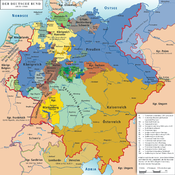
Kingdoms Electorates Grand Duchies Duchies Anhalt (Bernburg2 · Dessau2 · Köthen3) · Brunswick · Holstein · Limburg4 · Nassau · Saxe-Lauenburg · Saxony (Altenburg5 · Coburg-Saalfeld6 · Coburg-Gotha5 · Gotha-Altenburg6 · Hildburghausen6 · Meiningen)Principalities Hesse-Homburg · Hohenzollern (Hechingen7 · Sigmaringen7) · Liechtenstein · Lippe · Reuss (Elder · Junior) · Schaumburg-Lippe · Schwarzburg (Rudolstadt · Sondershausen) · Waldeck and PyrmontCity-states Other territories
outside of the
confederacyColonial possessions · Personal unions of Habsburg (Bukovina · Croatia · Galicia and Lodomeria · Hungary · Lombardy–Venetia · Serbian Voivodeship and Banat8 · Slavonia9 · Transylvania) · Personal union of Hanover (Great Britain and Ireland10) · Personal unions of Hohenzollern (East Prussia11 · Neuchâtel12 · Posen, Gr. Duchy13 · Posen, Prov.14 · Prussia, Prov.15 · West Prussia11) · Occupied: Schleswig161 w/o areas listed under other territories. 2 Merged with Anhalt from 1863. 3 until 1847. 4 from 1839. 5 from 1826. 6 until 1826. 7 until 1850. 8 1849–60. 9 as of 1849. 10 until 1837. 11 until 1829. 12 until 1848/57. 13 until 1848. 14 as of 1848. 15 as of 1829. 16 as of 1864. States of the North German Confederation (1866–71)
States of the North German Confederation (1866–71)Kingdoms 
Grand Duchies Duchies Principalities Schaumburg-Lippe · Schwarzburg (Rudolstadt · Sondershausen) · Lippe · Reuss (Elder · Junior) · Waldeck-PyrmontCity-states  States of the German Empire (1871–1918)
States of the German Empire (1871–1918)Kingdoms 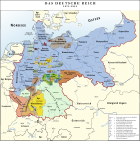
Grand Duchies Duchies Anhalt · Brunswick · Saxe-Altenburg · Saxe-Coburg and Gotha · Saxe-Lauenburg (until 1876) · Saxe-MeiningenPrincipalities Schaumburg-Lippe · Schwarzburg-Rudolstadt · Schwarzburg-Sondershausen · Lippe · Reuss Elder Line · Reuss Junior Line · Waldeck-PyrmontCity-states Other territories Elsaß-Lothringen · Colonial possessionsCategories:- Former monarchies of Europe
- Former countries in Europe
- States of the Holy Roman Empire
- States and territories established in 1352
- States and territories disestablished in 1918
- 1918 disestablishments
- States of the Confederation of the Rhine
- States of the German Confederation
- States of the North German Confederation
- States of the German Empire
- Dukes of Mecklenburg-Schwerin
- History of Mecklenburg-Vorpommern
- House of Mecklenburg-Schwerin
Wikimedia Foundation. 2010.

